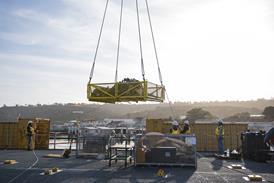Julian Moxon/PARIS
In October, the Ariane 503 launcher will release a cone-shaped craft on a re-entry mission, repeating what the USA first did with the Mercury capsule 37 years ago.
While this may seem like re-inventing the wheel, the Atmospheric Re-entry Demonstrator (ARD)mission is designed to show that, after several false starts, Europe has developed a capability for performing a full space mission cycle - from launch, to orbit and the return to Earth.
Not only that, but it will do so with unprecedented landing accuracy for a fully automatic vehicle - and on a minimal budget of ECU40 million ($36 million) - reflecting the "smaller, faster, cheaper" philosophy borrowed from NASA that was considered essential if the ARD was ever to see the light of day.
The need for economy was such that lead contractor Aerospatiale was allowed to choose its ARD partners on merit rather than by the traditional European Space Agency (ESA) principle of "geographic return", under which countries have to be given a share of the work proportional to their financial input.
RE-ENTRY DEMONSTRATION
In terms of the actual re-entry mission, ESA is not claiming any major technological advances with the ARD. "The point of it is more to demonstrate that we have a re-entry capability that ensures we're not locked out of any future return-to-Earth missions," says Aerospatiale head of manned spaceflight Gerard Breard. He makes no secret of the French company's hopes for the ARD, saying: "It is behind our efforts to convince ESA to pursue a European return-to-Earth vehicle."
Breard believes it to be "essential" that Europe is not left without an independent return-to-Earth capability, leaving it with no choice but to use US or Russian vehicles to bring astronauts and equipment back from the International Space Station (ISS), or elsewhere.
"The ARD is a meaningful and helpful tool to understand better all aspects of re-entry: materials, avionics and recovery," says ESA director of manned spaceflight Jorg Feustel-Buechl. "Bringing a vehicle from 28,000km/h to 0km/h involves solving enormous guidance, temperature and other issues," he adds
Talk of a follow-on to the Ariane 5 launcher centres on a re-usable lifting-body vehicle, for which the ARD is seen as providing vital input. "Re-usability will be on the table," says Feustel-Buechl, "and, to do so, we must have the knowhow for the crucial missing element - the return to Earth and, for that matter, descent into the atmospheres of other planetary bodies."
The ARD story is complicated, however, by European involvement in the NASA X-38 return-to-Earth demonstrator, which is intended as a precursor to the Crew Return Vehicle which will bring astronauts back to Earth from the ISS in the event of an emergency. France has not joined the effort, the Jospin Government - to the consternation of the French space industry - having effectively pulled out of manned spaceflight programmes last year.
Aerospatiale is already suggesting an unmanned follow-on to the ARD, the Atmospheric Re-entry Experimental Spacecraft, which would be an automated lifting-body vehicle able to explore cross-range flight and landing on a runway.
"We must demystify manned from unmanned return to Earth," says Breard, remembering France's abortive effort to pursue the Hermes manned spaceplane that would have sat atop the Ariane 5 for visits to the ISS, returning to a horizontal Shuttle-type landing.
USEFUL HERMES
The Hermes project never left the drawing board, proving too complex and expensive for ESA. During its short life, however, it proved a useful technology driver for the development of advanced materials and three-dimensional computer analysis of re-entry aerodynamics. It subsequently became clear that many of the technological hopes driving the effort were over-ambitious, yet much of the work, which was part of ESA's Manned Space Transportation Programme, has fed directly into the ARD.
"It helped solve a lot of software and engineering problems," says ESA's Feustel-Buechl. "With the ARD, we want to take a more measured approach so that we can be sure of negotiating from a position of strength in the future."
Accordingly, in late 1993, the decision was taken to pursue a programme that would "-pave the way for future re-entry vehicles". Aerospatiale, as the original Hermes prime contractor, was asked to take the lead in developing a high-speed, low-cost vehicle specifically aimed at proving a European re-entry capability.
"They came back with an ECU31 million proposal, which, in terms of unit costs, was between a third and a half that of a normal ESA programme," says Feustel-Buechl. The remaining costs involve ground segment and other support charges.
Aerospatiale took a 50% stake in the programme and subsequently awarded 20% of that to Belgium and 15% each to Germany and Italy. As prime contractor, the French company is responsible for overall vehicle design, assembly integration and testing, guidance and navigation, thermal protection and antennas.
Belgium's SABCA and SONACA build the ARD structure and ETCA the functional control bench. Germany's Daimler-Benz Aerospace looks after the reaction control system, while Alenia takes care of parachutes, flotation, and thermal and in-flight measurements. France's Matra Marconi Space is responsible for the functional electronics.
ARD: TECHNOLOGY AND TECHNIQUE
The European space agency's Atmospheric Re-entry Demonstrator programme has four aims:
validation of aerodynamic predictions; validation of the thermal protection design and materials; assessment during flight of navigation, guidance and control software; assessment during flight of braking parachute behaviour.Launched atop the Ariane 503, the ARD mission is due to last 1h 40min. After reaching an altitude of 875km, seven small thrusters will orient the craft for its automated re-entry. A combination of the global positioning system (GPS) and an onboard inertial navigation system will then navigate the vehicle as it snakes back and forth to reduce thermal stress during the 15min re-entry flight to a splashdown north of the Marquesa Islands in the Pacific Ocean.
The craft itself weighs 2,800kg, with a diameter of 2.8m at its widest point and a height of 2m. It is composed of four main elements: a light-alloy heatshield structure supporting the thermal protection system; a light-alloy conical structure housing the antenna and propulsion system; an ejectable rear cover and a hexagonal central tower, decoupled from the main structure to protect it from launch vibration, for mounting the electrical equipment, and the parachute and flotation balloons.
For the all-important thermal protection system, the ARD relies on a non-ablative heatshield coating that will lose only 1mm of its thickness during the descent. This maintains the shape of the heatshield, the part of the structure most sensitive to aerodynamic pressure as it descends through the atmosphere.
The shield consists of 93 tiles made from Aleastrasil, an Aerospatiale-developed silica material impregnated with phenolic resin, which is bonded to the metallic structure. Some tiles are equipped with sensors for gathering aerothermodynamic data during the re-entry.
The cone and back cover are made of 19mm-thick Norcoat cork panels, also developed by Aerospatiale, and which maintain the internal temperature of the craft at a stable 40¼C during re-entry, while external temperatures exceed 2,000°C on the heat shield and 1,000°C on the cone.
Attitude control is provided by seven hydrazine thrusters of 400N (90lb) thrust each, which function by "blowdown" from the pressurised fuel tanks mounted in the spacecraft. Three thrusters provide pitch control, and yaw and roll forces are each controlled by two thrusters. The technology for the thrusters - and particularly the understanding of the aerodynamic relationship between them and the craft - has had to be developed without reference to any US or Russian systems. "They weren't very helpful - we had to find out about that ourselves," says Breard.
Avionics equipment comprises an onboard computer, inertial guidance system, power supply, a launch sequencing system (to ensure that the ARD systems function in parallel with those of the Ariane 5), a redundant data transmission system, a GPS receiver and two static recorders. The capsule is completely automatic, with navigation, guidance and control and all mission sequencing managed by the onboard software.
Descent is slowed initially at an altitude of 14,000m, using a 0.91m-diameter extraction parachute, blown out of the top of the craft by a mortar-type device. At 13,000m, a 5.8m-diameter braking parachute deploys for 78s, slowing the ARD from 200m/s to 50m/s before being jettisoned and replaced by three main 22.9m-diameter parachutes. These are opened gradually to avoid heavy deceleration, and slow the craft to just 6.6m/s. At the end of the descent, the support ropes of one of them is cut, angling the ARD so that it enters the water at a 30° angle, thereby reducing the shock of impact.
If all goes well, the landing should occur within a 4km target area - considerably more accurate than the Apollo capsule landings, mainly because of the combined use of the GPS and inertial reference unit during the descent to angle the vehicle as it flies cross-range to the landing area. The aim is also to keep thermal flux to a minimum and reduce deceleration to between 3.5g and 5g. More than 200 onboard instruments will record the vehicle's performance as it does so.
Recovery of the ARD will be accomplished by the French navy after a 10h delay - as a precaution against hydrazine leaks and to allow the structure to cool fully (because of the heat inertia of the craft, the temperature reaches its maximum 1.5h after splashdown).
Source: Flight International























